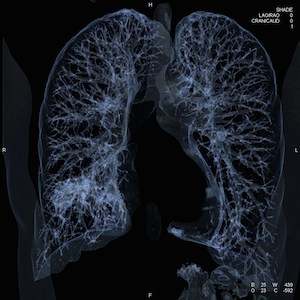During a normal day, most of us inhale and exhale 25,000 times—and we probably take each breath for granted. A person with lung cancer can have extreme difficulty breathing and, as a result, is not able to supply their body with the oxygen it needs.
| Watch our video to learn how low-dose CT lung cancer screenings are impacting patient lives, and how providers can market their program. |
As a healthcare provider, you know the harsh truth about lung cancer: it doesn’t usually cause symptoms until the cancer is too advanced for successful treatment—killing more than half of patients within one year of being diagnosed.
According to the American Lung Association, 158,000 Americans are expected to die from lung cancer in 2016—accounting for approximately 27 percent of all cancer deaths. On top of that, 224,000 new cases of lung cancer will also be diagnosed this year.
That’s why annual lung cancer screening with low-dose computed tomography (LDCT) for high-risk patient populations is so groundbreaking. Studies have shown these screenings contribute to a 20 percent reduction in mortality. In addition, research continues into pharmaceutical and surgical innovations that will help the medical community to adopt a more personalized approach to lung cancer screening. Examples of this include breath tests that could identify lung cancer, as well as image-guided minimally invasive procedures for removing cancerous tissue through small chest incisions.
Promoting Your LDCT Program
For the past two years, we’ve talked with a lot of you about CT lung cancer screening programs. Many of you are well on your way, while others ave yet to get their feet wet.
No matter where you’re at, we’ve learned that it’s important to market your program every step of the way, and referring physicians are a key audience. In the beginning, you must educate physicians about your intent to start a program, and then keep engaging them on a monthly or quarterly basis with key messages and tips to help them make referrals—such as a flier with inclusion/exclusion criteria, frequently asked questions, and the contact information for your facility’s physician liaison. I invite you to get more tips to promote your program in this LDCT screening program guide.
We’re also excited to share with you Siemens Healthineers’ online marketing toolkit to help you promote your lung cancer screening program. The toolkit includes templates for:
- Referring physician letters and postcards

- Patient appointment reminder postcards
- Patient promotional letter
- Siemens CT product images
- Clinical images of CT lung scans (high-resolution)
How are you promoting lung cancer screenings at your facility? Where are you at in the screening journey? We’d love to hear from you in the comments below.
Looking for some assistance marketing your LDCT screening program? Cassling provides customized materials to help you educate your patients, community and physicians about your services. Learn about our marketing packages.






Comments